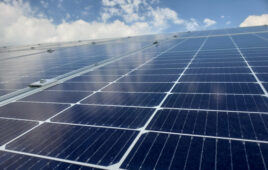Hemlock Semiconductor Operations (HSC) has acquired a DuPont business that makes trichlorosilane (TCS), the primary raw material used in producing the ultra-pure polysilicon HSC supplies to the semiconductor and solar industries.
By acquiring the TCS operations in Midland, Michigan, HSC will be better able to control supply and substantially reduce costs. The Midland plant is about 20 miles north of HSC’s sprawling campus just west of Saginaw, Michigan.
HSC’s new lower cost position, coupled with its ability to produce polysilicon sustainably, will enable the company to boost its competitiveness as solar energy purchasers increasingly look for ways to decarbonize their supply chains.
“This acquisition will strengthen our already strong semiconductor position,” said HSC Chairman and CEO Mark Bassett. “It will help accelerate our growth in the solar sector since we’ll be able to offer ultra-pure polysilicon of exceptional quality that reduces the carbon footprint of producing solar panels at a substantially lower cost.”
Bassett called the acquisition of the trichlorosilane asset “a major milestone” for HSC, enabling the company’s manufacturing to become fully integrated with its main raw material. Polysilicon is used to make solar PV cells and the integrated circuits for electronics which are the building blocks for everything from smartphones to autonomous vehicles.
Though solar PV produces no emissions in its operations and typically offsets greenhouse gas (GHG) and other emissions from fossil-based electricity generation, there is more to cutting carbon footprint than one might think. The GHG emissions associated with how things are produced and transported can have an appreciable impact on the “embodied carbon” of any given product. Solar cells are no different in that regard because major components in solar cell technology like polysilicon require energy intensive processes to purify them into solar grade polysilicon.
HSC has been working hard to improve the energy efficiency and energy management of its operations to reduce its carbon footprint. That has led to very low embodied GHG emissions in the ultra-pure polysilicon that HSC manufactures. By boosting its environmental performance, HSC has enabled ultra-low-carbon solar panels with up to 50 percent less embodied carbon than typical solar.
“Not all solar is created equal. If end-users choose solar energy products more carefully by opting for source materials made through energy efficient processes, they can further decarbonize their supply chains and reach their sustainability goals faster,” added Bassett.
News item from HSC





“HSC has been working hard to improve the energy efficiency and energy management of its operations to reduce its carbon footprint. That has led to very low embodied GHG emissions in the ultra-pure polysilicon that HSC manufactures. By boosting its environmental performance, HSC has enabled ultra-low-carbon solar panels with up to 50 percent less embodied carbon than typical solar.”
Now in the utility scale or commercial or community scale solar PV system, First Solar has had a solution since 1999. Their CdTe panel technology is said to be 7 times less energy intensive than mono-crystalline solar PV to manufacture. Also First Solar has been the first to have a cradle to cradle recycling system in place.
“In realising that the recycling
of PV modules at the end of their useful ‘life’ will resolve any environmental concerns, as well as
create an alternative Te (and Cd) resource, First Solar established the first global and
comprehensive module recycling program in the PV industry in 2005. Recycling facilities are now
operational in all First Solar manufacturing plants worldwide, with a total annual recycling capacity
First Solar’s CdTe module technology – performance, life cycle, health and safety
impact assessment Dec-15 22 of approximately 26 000 tons (Experts, 2015).”
In the ‘race’ to 25% efficient panels, the large crystalline solar PV manufacturers have conveniently forgotten, early 18% efficient panels of the past are still online and churning out solar PV power today. Panels in the thousands, what will happen at the end of life of these very same panels? First Solar has already proven cheap long lasting panels, better low light harvest efficiency and a recycling program in effect since 2005.
First Solar has just announced, all factories will be powered by solar PV by 2028 World Wide.
Be good to actually put some numbers to all this. What is ‘ultra-low’ vs. what the baseline is today. I bet the numbers are still very high and very very high.